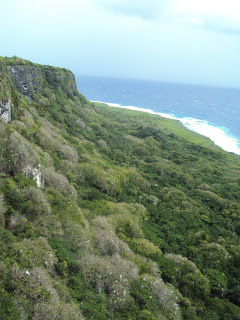In my renewed attempt to keep everyone updated, I thought I would post again since I've completed my first full week on the job.
Thus far it has been hot, humid, and sunny, which is not too surprising considering our location. I've been handing the heat fairly well (even turning the fan off some nights!) although steep climbs through the jungle can be fairly epic depending on the time of day.
Although I am still quite new at this, the job is starting to make a bit of sense; we have two birds who still have radio-transmitters, and both birds need to be seen each day. Depending on where the birds are, this can either be really straightforward, or needlessly complecicated. The two birds have been pretty cooperative, although for a moment we thought the battery had died in one. Turns out she was hiding behind a rock off the edge of a cliff. Silly birds.
The other main portion of the job is nest searching - this is conducted in predetermined territories and seems a bit hit or miss. Generally we hang out around old nest sites, as birds will often re-nest nearby, sometimes using materials from old nests. Other times we wander slowly through the jungle, trying to annoy nesting pairs into giving up their location. The nesting season is winding down, but Mike and I managed to find an active nest our very first afternoon nest searching on our own! We also (potentially) found an incubating nest yesterday, although that remains to be confirmed. That brings our total number of nests up to four, plenty to keep us busy until we learn the ropes.
Free time has been spent exploring the remaining bits of the island, snorkeling, reading (a lot), perusing the grocery stores, and getting a garden started. Not sure how to grow things in the tropics, but we have a lot of seeds started and about 25 cabbage seedlings - hopefully some other stuff will sprout soon. If not I will get tired of cabbage quickly. More photos to come - stay tuned!
Thursday, February 28, 2013
Tuesday, February 19, 2013
Life in the Tropics
For those of you who don’t yet know, Mike and I accepted
positions as Field Technicians for a study on an endangered, endemic crow
species, on Rota. Rota is a tiny island in the Commonwealth of the Northern
Marianas Islands (think right near Guam), which is situated smack-dab in the
middle of the Pacific Ocean, about halfway between Japan and New Guinea.
Now that you know where we are, a bit about what we’re
doing. This particular project has been running for a few years, and has been
concerning with finding the birds, banding the fledglings, and generally trying
to keep them alive. Current estimates show that there are ~ 100 breeding pairs
left, which isn’t very many.
Even though we’ve been here since Saturday, we’ve only done
two ‘official’ days at work. So far we’ve been using telemetry to find the two
birds who still have radio backpacks on (which usually takes a good deal of the
morning), and using the afternoon to search for nests in the other parts of the
island. These birds will breed year round, and a lot of nests have recently
failed, so there is a chance that some birds are starting to re-nest. That
being said, they are very hard to find if they don’t want to be found. Often
birds will re-nest near old nest sites, so our approach is to go to an old
nest, and listen for crows. So far I haven’t been too successful – heard nothing
yesterday while in two separate territories. Today was much more successful –
we found a banded bird (randomly), hung out with Red (who we were looking for),
and heard one bird off in the distance while nest searching. Furthermore, I completed a rite of passage –
getting stung by my first (and second) wasp. They were not as awful as I
expected, but I plan on being super-cautious in the future.
A few photos are below. More will trickle in.
 |
| Mike makes a critical addition to United Airline's map |
 |
| View from the Bird Sanctuary - all the white dots are red-footed boobies nesting |
 |
| This is a blurry photo of a Mariana Crow - apologies until I get a nicer camera |
I will (sincerely) try and keep this updated a bit more than
previously (i.e. more than once every two years), so check back to see how life
in the jungle is progressing!
Subscribe to:
Posts (Atom)